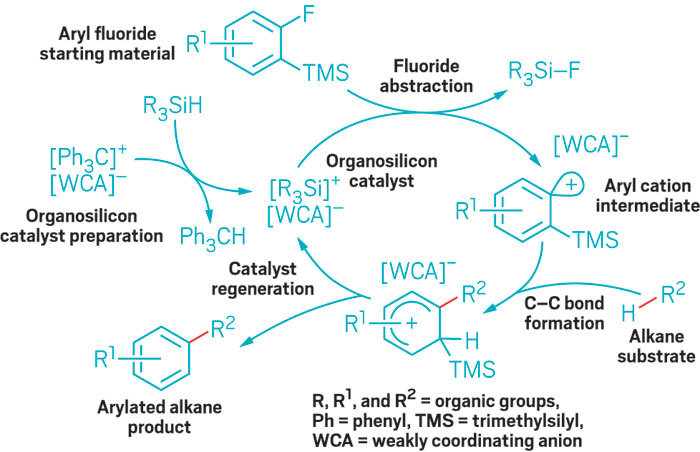Advertisement
Grab your lab coat. Let's get started
Welcome!
Welcome!
Create an account below to get 6 C&EN articles per month, receive newsletters and more - all free.
It seems this is your first time logging in online. Please enter the following information to continue.
As an ACS member you automatically get access to this site. All we need is few more details to create your reading experience.
Not you? Sign in with a different account.
Not you? Sign in with a different account.
ERROR 1
ERROR 1
ERROR 2
ERROR 2
ERROR 2
ERROR 2
ERROR 2
Password and Confirm password must match.
If you have an ACS member number, please enter it here so we can link this account to your membership. (optional)
ERROR 2
ACS values your privacy. By submitting your information, you are gaining access to C&EN and subscribing to our weekly newsletter. We use the information you provide to make your reading experience better, and we will never sell your data to third party members.
Synthesis
Pinning aryl groups on alkanes
Organosilicon-catalyzed reaction functionalizes even notoriously inert methane, without help from precious transition metals
by Stu Borman
March 31, 2017
| A version of this story appeared in
Volume 95, Issue 14

Unactivated alkanes are difficult to functionalize, and most catalysts that derivatize them by opening hydrocarbon C–H bonds are based on precious transition metals.
Researchers have now developed a class of intermolecular C–H arylation reactions that use catalysts made from more-abundant materials: silicon and boron. The reaction adds aryl groups to C–H bonds of simple hydrocarbons, including to the notoriously inert bonds in methane, at mild temperatures (Science 2017, DOI: 10.1126/science.aam7975).
“Alkanes are bulk components of gasoline and as such are supercheap commodities, which, if converted to functionalized compounds, would become much more valuable,” comments Jay Siegel of Tianjin University, who developed a related intramolecular reaction but was not involved in the new study. “This is an area rich in prospects, with a bright future for chemical synthetic methods development.”
Hosea M. Nelson and coworkers at the University of California, Los Angeles, prepare the new organosilicon catalyst from an organosilane and a weakly coordinating carborane anion. The catalyst defluorinates an aryl fluoride starting material, likely generating an aryl cation intermediate that inserts electrophilically into a C–H bond of an alkane substrate to yield an arylated alkane. A key trimethylsilyl group on the aryl fluoride aids fluoride abstraction, helps the cation react quickly, and eases catalyst regeneration.
At press time, Nelson was scheduled to discuss the findings this week in a Division of Organic Chemistry presentation at the ACS national meeting in San Francisco.
“Electrophilic reactions with methane are exceptionally rare, and the C–H functionalization of methane reveals the extraordinary reactivity of this system,” says Douglas Klumpp of Northern Illinois University, an expert on highly reactive electrophilic intermediates. The clever use of a trimethylsilyl group, he says, enabled the researchers “to tame a lion,” the aryl cation intermediate, “and that lion is able to do some very nice tricks.” However, Klumpp notes that one limitation of the chemistry is that “the aryl fluoride starting materials are expensive or difficult to obtain.”
“The chemistry isn’t ready for prime-time applications,” Nelson says. “It’s a new strategy that will hopefully fuel further study. We need to find ways to improve the reaction’s efficiency, selectivity, and substrate scope. We have filed a provisional patent and look forward to working with the chemical industry to develop practical applications.”


Join the conversation
Contact the reporter
Submit a Letter to the Editor for publication
Engage with us on Twitter